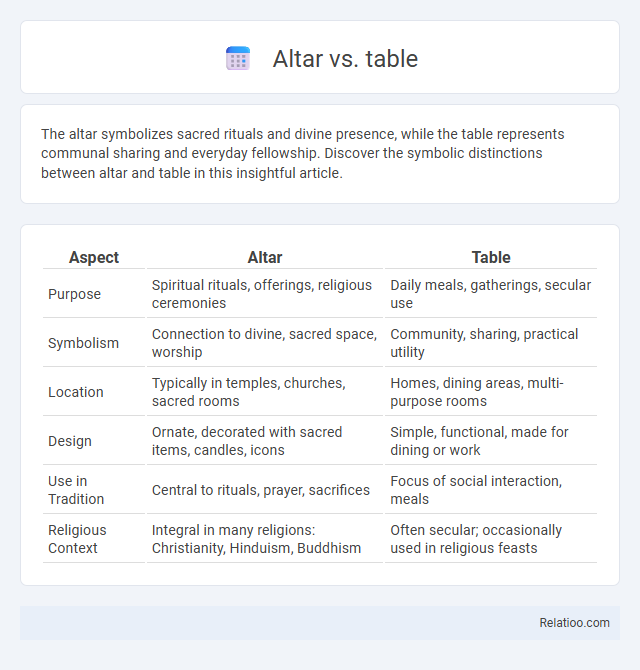The altar symbolizes sacred rituals and divine presence, while the table represents communal sharing and everyday fellowship. Discover the symbolic distinctions between altar and table in this insightful article.
Table of Comparison
| Aspect | Altar | Table |
|---|---|---|
| Purpose | Spiritual rituals, offerings, religious ceremonies | Daily meals, gatherings, secular use |
| Symbolism | Connection to divine, sacred space, worship | Community, sharing, practical utility |
| Location | Typically in temples, churches, sacred rooms | Homes, dining areas, multi-purpose rooms |
| Design | Ornate, decorated with sacred items, candles, icons | Simple, functional, made for dining or work |
| Use in Tradition | Central to rituals, prayer, sacrifices | Focus of social interaction, meals |
| Religious Context | Integral in many religions: Christianity, Hinduism, Buddhism | Often secular; occasionally used in religious feasts |
Definition of Altar and Table
An altar is a sacred structure used in religious rituals for offerings, sacrifices, or worship, often symbolizing a connection between the divine and the human. A table is a flat, usually horizontal surface supported by legs, designed primarily for practical activities like dining, writing, or holding objects. Unlike tables, altars hold significant spiritual meaning and are central in various ceremonial contexts across cultures and faiths.
Historical Origins of Altars and Tables
Altars and tables have distinct historical origins rooted in religious and communal practices; altars traditionally functioned as sacred platforms for offerings and rituals in ancient civilizations, reflecting spiritual and sacrificial significance. Tables, conversely, evolved primarily as practical furniture for dining and gathering, symbolizing community and social interaction. Understanding the contrasting origins of altars and tables clarifies your appreciation of their roles in cultural and religious contexts today.
Symbolic Significance in Religious Contexts
The altar symbolizes a sacred space for sacrifice and divine presence, often representing a bridge between the human and the sacred in various religious traditions. A table, while also used in religious rituals like the Christian Eucharist, primarily symbolizes fellowship, sharing, and communal participation in the faith. Distinctions in symbolic significance highlight the altar as a focal point of worship and offering, whereas the table emphasizes unity and spiritual nourishment within the religious community.
Functional Differences Between Altar and Table
Altars serve primarily as sacred spaces for religious rituals, often constructed to hold offerings and symbolize a connection between the divine and worshippers, whereas tables function as practical surfaces for dining or work without inherent spiritual significance. Altars typically feature specific design elements like candles, cloths, or icons that signify reverence and ritual use, contrasting with the simple, utilitarian structure of tables designed for everyday tasks. The functional difference lies in the altar's role in ceremonial context versus the table's role in ordinary, secular activities.
Materials and Design Elements
Altar, table, and altar tables differ significantly in materials and design elements, reflecting their distinct purposes. Altars are traditionally crafted from stone, wood, or metal, often featuring intricate carvings, religious symbols, and durable finishes to withstand ceremonial use. Tables prioritize practicality with various woods, metals, or glass, emphasizing functionality and simple design, while altar tables blend these aspects, showcasing sacred motifs combined with sturdy construction to support worship practices; Your choice depends on intended use and aesthetic preference.
Use in Various Religious Traditions
Altars in religious traditions serve as sacred spaces for offerings, prayers, and rituals, often symbolizing a divine presence or connection. Tables, used in Christian liturgies for Eucharist celebrations, function as practical surfaces for sacraments, emphasizing communal sharing and remembrance. Your understanding of these elements is enhanced by recognizing altars' spiritual symbolism across diverse faiths, whereas tables typically hold a more ritualistic and functional role.
Cultural Interpretations of Altars and Tables
Altars and tables hold distinct cultural significance shaped by religious and social contexts, with altars often symbolizing sacred spaces for ritual offerings and spiritual connection, while tables serve as communal hubs for sharing meals and fostering social bonds. In many traditions, altars are intricately decorated with symbols, candles, and offerings representing divine presence or ancestral reverence, contrasting with tables that prioritize functionality and collective human interaction. The interpretation of altars transcends mere physical structures to embody spiritual devotion, whereas tables emphasize unity and fellowship within cultural practices.
Evolution of Ritual Practices
The evolution of ritual practices shows a distinct transformation in the use of altars and tables, where altars traditionally served as sacred platforms for offerings and divine communication in ancient cultures. Over time, tables have been integrated into religious ceremonies to provide functional surfaces for communal meals and symbolic acts, reflecting shifts in worship styles and accessibility. Your understanding of these elements deepens by recognizing how their roles have adapted to meet changing cultural and spiritual needs throughout history.
Modern-Day Applications and Adaptations
Modern-day applications of altars often emphasize spiritual significance and personalized expression, while tables serve practical, everyday functions like dining or work. Altars are adapted in contemporary settings as focal points for meditation, rituals, or cultural ceremonies, integrating modern materials and designs to suit varied spaces and lifestyles. Your choice between an altar and a table depends on the intended purpose--whether for sacred use or functional utility--reflecting evolving interpretations and uses in modern contexts.
Altar vs Table: Which Is Appropriate for Your Purpose?
An altar typically serves a sacred or ritualistic purpose, often found in religious or spiritual settings, symbolizing a place for offerings, prayers, or ceremonies. A table, on the other hand, is a multifunctional piece of furniture used for dining, work, or display, lacking inherent spiritual significance. Understanding your purpose is essential; if you seek a dedicated space for worship or ritual, an altar suits your needs, whereas a table is more appropriate for everyday practical uses.

Infographic: Altar vs Table
 relatioo.com
relatioo.com